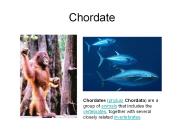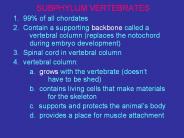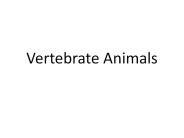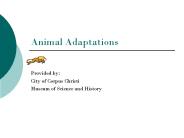Ectotherms PowerPoint PPT Presentations
All Time
Recommended
BIOL 3300 Vertebrate Zoology: Ectotherms - Herpetology http://www.amphibian.com.au/ Open with Prayer Take attendance Course Page (NOT Angel) http://people.nnu.edu ...
| PowerPoint PPT presentation | free to view
Thermoregulation in Ectotherms Benny Cheong 3I305 Ectotherms Ectotherms are animals which regulate their body temperature via external means. These animals are ...
| PowerPoint PPT presentation | free to view
Enzymes: Helper Protein molecules * Enzymes work within narrow temperature ranges. Ectotherms, like snakes, do not use their metabolism extensively to regulate ...
| PowerPoint PPT presentation | free to download
Heat/Osmotic Regulation & Excretory System Chapter 25 ThermoRegulation Many Ectotherms / All Endotherms maintain a constant body temperature. Hormonal changes alter ...
| PowerPoint PPT presentation | free to download
Phylum Chordata Invertebrate Chordates Ex. Tunicates/Sea Squirts Ex. Lancelet Fishes Ectotherms (cold-blooded) Lay eggs without a shell External fertilization Jawless ...
| PowerPoint PPT presentation | free to view
... (keratin), ectothermic, three chambered heart (i.e. turtles, lizards, and alligators) Major Divisions Birds (subdivision of reptiles): amniotic eggs, scales ...
| PowerPoint PPT presentation | free to view
KEY CONCEPT Reptiles were the first amniotes. Reptiles are a diverse group of amniotes. Reptiles share several characteristics. ectotherms covered with dry scales ...
| PowerPoint PPT presentation | free to download
Scutes on a live Alligator Alligator Scute Fossils Turtle Scutes Reptiles are Ectothermic Most reptiles are ectothermic ... American Alligator 8 to 13 feet long 800 ...
| PowerPoint PPT presentation | free to download
Vertebrates Stephanie Johns Definition of Vertebrates organisms with many cells heterotrophic endothermic or ectothermic Characteristics of Vertebrates Backbones ...
| PowerPoint PPT presentation | free to view
General Zoology Unit Five Respiration in Fish Respiration in Fish Vertebrate Thermoregulation Ectothermic obtaining body heat from the environment Poikilothermic ...
| PowerPoint PPT presentation | free to view
Daphnia and the Effects of Temperature What does increasing temperature do to the heart rate of an ectothermic organism and why? What is daphnia?
| PowerPoint PPT presentation | free to view
Evolution and Life in the Ocean. Classification of Oceanic Life. Physical Factors Affecting Marine Life. Light. Temperature. Metabolic rate. Ectothermic ...
| PowerPoint PPT presentation | free to download
Reptiles. Reptile Characteristics. Ectothermic body temperature determined by environment ... Reptile Examples. Snakes. Turtles. Alligators. Crocodiles ...
| PowerPoint PPT presentation | free to view
Snakes. While venomous snakes comprise a minority of the species, some possess potent ... Like all reptiles, snakes are ectothermic and covered in scales. ...
| PowerPoint PPT presentation | free to view
Controlling the Internal Environment Thermoregulation Osmoregulation Excretion Thermoregulation Ectothermic Endothermic Poikilothermic Homeothermic Heat Exchange Heat ...
| PowerPoint PPT presentation | free to download
KEY CONCEPT Reptiles were the first amniotes. Reptiles are a diverse group of amniotes. Reptiles share several characteristics. ectotherms covered with dry scales ...
| PowerPoint PPT presentation | free to view
Facultative ectothermy (NOTE: this is actually correct endotherms become more ... Biggest example are marmots (~8 kg) This bear is drugged! This squirrel is not! ...
| PowerPoint PPT presentation | free to view
lamnid sharks. insects (e.g., moths, bees) at least eight genera of plants ... many ectotherms (e.g., lizards) combine activities, alternating between basking, ...
| PowerPoint PPT presentation | free to view
Class Amphibia amphibians such as frogs, toads, and salamanders ... The fish, amphibians, and reptiles are all cold-blooded, or ectothermic; birds ...
| PowerPoint PPT presentation | free to view
Fiddler crabs (Uca pugilator) like all ectotherms behaviorally and ... If this were true male fiddler crabs with larger chelipeds may be able to ...
| PowerPoint PPT presentation | free to view
Endothermic and Ectothrmic Animals SC 6-3.3 Vertebrate Animals All animals respond to changes in the environmental temperature. Vertebrate animals differ in their ...
| PowerPoint PPT presentation | free to view
Chordate Chordates (phylum Chordata) are a group of animals that includes the vertebrates, together with several closely related invertebrates.
| PowerPoint PPT presentation | free to download
Preferred Temperature, Metabolic Rate, and Circadian Rhythms ... Some circadian patterns were evident: turtles moved more when the lights were on ...
| PowerPoint PPT presentation | free to view
Kidneys excreted excess calcium, magnesium, sulfate w/small loss of water. * Osmotic Challenges in Freshwater Animals Their problem is the opposite of marine animals.
| PowerPoint PPT presentation | free to download
Chapter 40-Coordination and Control Control and coordination within a body depend on the endocrine system and the nervous system The endocrine system transmits ...
| PowerPoint PPT presentation | free to download
Comparative Vertebrate Physiology ... larger Change shape ... the day and night Large body size Comparative Vertebrate Physiology Temperature relations ...
| PowerPoint PPT presentation | free to view
Chapter 40 Basic Principles of Animal Form and Function
| PowerPoint PPT presentation | free to view
Vertebrates: Introduction A: Classification all belong to Phylum Chordata B: Shared Characteristics Have a backbone encases/protects the dorsal nerve cord (spine ...
| PowerPoint PPT presentation | free to download
Vertebrates are Animals with a backbone Chordate What are they- An animal that has, for al least some stage of its life, a dorsal hollow nerve cord; a notochord ...
| PowerPoint PPT presentation | free to view
Phylum Chordata Phylum Chordata Invertebrate chordates Tunicates and lancelets Have notochord, gill slits Vertebrates fish, amphibians, reptiles, birds, mammals ...
| PowerPoint PPT presentation | free to view
Animal Unit If you see green, it is a hyper link to a video or a web site. Just click on it to view. Standard 1 Animals are organisms that are multi-cellular but ...
| PowerPoint PPT presentation | free to download
SUBPHYLUM VERTEBRATES 1. 99% of all chordates 2. Contain a supporting backbone called a vertebral column (replaces the notochord during embryo development)
| PowerPoint PPT presentation | free to download
Chordates and Vertebrates At one time in their development ALL chordates have: Notochord flexible, rod-like structure along the back of the organism
| PowerPoint PPT presentation | free to download
Vertebrates Phylum Chordata 4 basic characteristics: Notochord supporting rod dorsally located, below the nerve cord, replaced by vertebral column in most ...
| PowerPoint PPT presentation | free to download
II) Fish. A) Agnatha: jawless fish. 1) suction mouth. 2) notochord remains. a)lack bony skeleton cartilage. 3) ex. lamprey and hagfish *
| PowerPoint PPT presentation | free to download
Classification Grouping & Identifying Living Things This Powerpoint is hosted on www.worldofteaching.com Please visit for 100 s more free powerpoints
| PowerPoint PPT presentation | free to view
Temperature, Osmotic Regulation and the Urinary System Chapter 50
| PowerPoint PPT presentation | free to download
Overview of the Animal Kingdom CSCOPE CSCOPE Animals are Multicellular Eukaryotic Heterotrophic Cells lack cell walls CSCOPE There are 9 Major Phyla Porifera ...
| PowerPoint PPT presentation | free to view
Chordates NonVertebrate Chordates, Fish, Amphibians, Reptiles and Mammals
| PowerPoint PPT presentation | free to view
A-1 A-2 A-3 B-1 B-2 B-3 C-1 C-2 C-3 D-1 D-2 D-3 E-1 E-2 E-3 F-1 F-2 F-3 G-1 G-2 G-3 H-1 H-2 H-3 Name-1 Name-2 Name-3 Name-4 Name-5 Name-6
| PowerPoint PPT presentation | free to download
Title: Slide 1 Author: Cindy Shannon Last modified by: cshannon Created Date: 2/8/2006 5:22:38 PM Document presentation format: On-screen Show (4:3)
| PowerPoint PPT presentation | free to download
Vertebrates Fishes, Amphibians, Birds, Reptiles, Mammals Biology B Nonvertebrate Chorodate Choradate Dorsal hollow nerve cord Notochord Pharyngeal pouches Tail that ...
| PowerPoint PPT presentation | free to download
Title: Lecture 11: Controlling the Internal Environment I - Regulation of Body Temperature Author: Zoology Last modified by: Zoology Created Date
| PowerPoint PPT presentation | free to download
Title: Table of Contents Author: Wendy Beck Last modified by: sa Created Date: 10/16/2000 7:08:56 PM Document presentation format: On-screen Show Company
| PowerPoint PPT presentation | free to download
amphibians & reptiles are adapted for life on land vertebrates adapted to live on land. amphibians have moist skin & lay eggs without shells. reptiles have dry, scaly ...
| PowerPoint PPT presentation | free to download
Unit 5 Kingdom Animalia Part Three of Notes: Vertebrates*
| PowerPoint PPT presentation | free to download
Ch. 40 Warm up Define and give an example of homeostasis. Sequence the organization of living things from cell to biome. Describe negative and positive feedback.
| PowerPoint PPT presentation | free to view
Animal Tissues What are tissues? Groups of cells with common structure and function. Epithelial Tissues Connective Tissue Nervous Tissue Muscle Tissue
| PowerPoint PPT presentation | free to view
456789:CDEFGHIJSTUVWXYZcdefghijstuvwxyz GpSs tFTO ... ( ( ( ( ( ( ( ( ( ( ( ( ( ( ( ( ( ( ( ( ( ( ( ( ( ( ( ...
| PowerPoint PPT presentation | free to view
Zoology Chapter 6 Ecology Ms. K. Cox Introduction Ecology is the study of organisms and their relationships to each other, as well as the components of their environment.
| PowerPoint PPT presentation | free to download
Amniotes through Eutherians Chapter 34.6-34.8 By: Francisco Berrios and Siria Arzuaga Amniotes A group of tetrapods that trace back to the same common ancestor.
| PowerPoint PPT presentation | free to download
Title: Biology 5/15/07 Objectives: To learn about taxonomy. Class Topics Hand in Shark Key W.S. before the bell rings Chapter 16 exam review
| PowerPoint PPT presentation | free to download
Homeostasis Chapter 30
| PowerPoint PPT presentation | free to download
Animal Adaptations Provided by: City of Corpus Christi Museum of Science and History What is an adaptation? An adaptation is a change in an animal s physical ...
| PowerPoint PPT presentation | free to view
Vertebrate Review Questions Which fish is a parasite? Lamprey Shark Skate Bass What is a shark s skeleton composed of? Bone Chitin Cartilage Notochord Which fish is ...
| PowerPoint PPT presentation | free to download
PowerPoint Presentation ... Classification
| PowerPoint PPT presentation | free to download
























































